The iodine clock reaction, discovered by Hans Heinrich Landolt in 1886, is a classic chemical demonstration showcasing reaction kinetics. It visually illustrates how reaction rates change over time, providing insights into chemical kinetics principles and the factors influencing reaction speeds; This experiment is widely used in educational settings to teach concepts like reaction mechanisms, rate laws, and the role of catalysts. Its colorful and time-dependent nature makes it engaging for students while emphasizing the importance of accurate measurements and observations in chemical studies.
Overview of the Experiment
The iodine clock reaction is a chemical demonstration that visually displays the principles of chemical kinetics. It involves the reaction of iodine with other substances, producing a color change that signifies the reaction’s progression. This experiment is designed to illustrate how reaction rates can be measured and how factors such as concentration, temperature, and catalysts influence these rates. By observing the time it takes for the reaction to reach a specific endpoint, students can gain insights into the kinetics of chemical reactions. The experiment is often self-timed, with the color change serving as a clear indicator of the reaction’s completion. It is a practical and engaging way to study reaction dynamics and their underlying principles.
Historical Background and Discovery
The iodine clock reaction was first discovered by Swiss chemist Hans Heinrich Landolt in 1886. Landolt, known for his work on chemical kinetics, developed this reaction as a way to visually demonstrate the principles of reaction rates and timing. His discovery laid the foundation for modern studies of chemical kinetics, providing a practical example of how reaction rates can be observed and measured. Over time, the experiment has been adapted and refined for educational purposes, making it a staple in chemistry classrooms worldwide. Landolt’s work not only advanced the field of chemistry but also created an engaging tool for teaching complex concepts in a hands-on manner.
Key Concepts and Objectives
The iodine clock reaction introduces fundamental concepts in chemical kinetics, such as reaction rates, catalysts, and concentration effects. Key objectives include understanding how different factors influence reaction speeds and observing the visible color change as iodine is liberated. Students learn to calculate rate constants and determine reaction orders, enhancing their analytical skills. The experiment also emphasizes the importance of accurate measurements and data analysis. By exploring these concepts, participants gain hands-on experience with chemical kinetics principles, preparing them for advanced studies in chemistry and related fields. This experiment serves as a practical bridge between theoretical knowledge and real-world applications in chemical reactions and kinetics research.
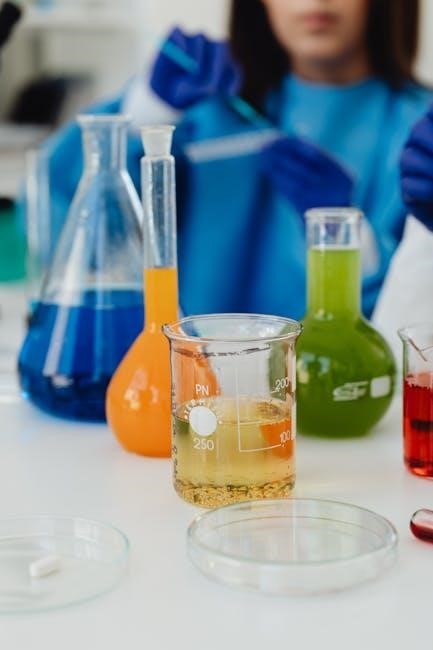
Principles of Chemical Kinetics in the Iodine Clock Reaction
The iodine clock reaction demonstrates chemical kinetics principles, showing how reaction rates depend on concentration, temperature, and catalysts. The visible color change illustrates kinetic processes in action.
Factors Affecting Reaction Rates
In the iodine clock reaction, reaction rates are significantly influenced by several factors. The surface area of reactants plays a role, as increased surface area accelerates the reaction. Concentration is another critical factor; higher concentrations of reactants typically increase reaction rates due to more frequent collisions. Temperature also impacts the reaction, with higher temperatures generally speeding up the process by increasing molecular energy. Additionally, the presence of catalysts can alter reaction rates by lowering activation energy, thereby accelerating the reaction without being consumed. These factors demonstrate how kinetic principles govern chemical reactions, making the iodine clock reaction a practical tool for studying reaction dynamics.
Reaction Mechanism and Rate Law
The iodine clock reaction involves a series of steps where hydrogen peroxide (H2O2) reacts with iodide ions (I^-) in an acidic environment to produce iodine (I2). The reaction mechanism includes the formation of an iodine oxide intermediate, which then decomposes to release iodine. The rate law for this reaction is expressed as:
rate = k [H2O2][I^-]^2 [H+]
Here, [H2O2], [I^-], and [H+] represent the concentrations of hydrogen peroxide, iodide ions, and hydrogen ions, respectively. The rate constant (k) depends on temperature and catalysts present. This rate law indicates that the reaction is first-order with respect to H2O2 and H+, and second-order with respect to I^-. Understanding the mechanism and rate law is crucial for predicting and controlling the reaction’s timing and outcome.
Role of Concentration and Temperature
The rate of the iodine clock reaction is significantly influenced by the concentration of reactants and temperature. Increasing the concentration of hydrogen peroxide (H2O2) or iodide ions (I^-) accelerates the reaction, as more collisions between reactant molecules occur. Temperature also plays a critical role, with higher temperatures increasing the reaction rate by providing more energy for collisions. This effect is described by the Arrhenius equation, where the rate constant (k) increases exponentially with temperature. Understanding these factors allows precise control over the reaction’s timing, making it essential for educational demonstrations and kinetic studies. Both concentration and temperature are-key parameters in optimizing the iodine clock experiment.
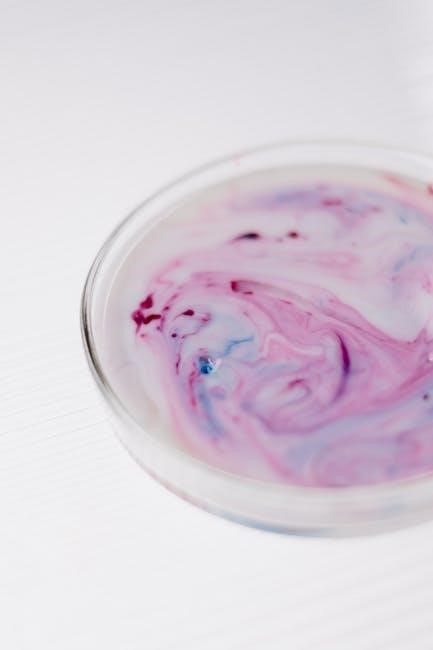
Experimental Setup and Safety Precautions
- Gather materials: beakers, thermometers, and chemicals like H2O2, KI, and starch.
- Wear safety goggles and gloves to protect against splashes.
- Mix solutions carefully, avoiding skin contact.
- Monitor temperature and use a stopwatch for timing.
Materials and Equipment Required
The iodine clock reaction experiment requires specific materials and equipment to ensure accurate and safe results. The primary chemicals needed are hydrogen peroxide (H2O2), potassium iodide (KI), and starch, which acts as an indicator. Additionally, distilled water is essential for preparing the solutions. For mixing and measuring, 100 ml or 250 ml beakers and a measuring cylinder are necessary. A thermometer is recommended to monitor temperature, and stirring rods are used to mix the solutions thoroughly. Safety gear, including goggles and gloves, is crucial to protect against chemical splashes. A stopwatch or timer is also needed to measure the reaction time accurately. Optional equipment includes a burette for precise solution addition, though it may not be essential for basic procedures. Ensuring all materials are available and properly used is vital for the experiment’s success and safety.
Safety Measures and Handling of Chemicals
The iodine clock reaction involves handling chemicals that require proper safety measures. Wear protective goggles and gloves to prevent skin and eye contact. Hydrogen peroxide can be corrosive, so handle it carefully. Potassium iodide and iodine solutions should be managed with caution, as they can stain surfaces. Ensure the experiment is conducted in a well-ventilated area to avoid inhaling fumes. In case of spills, immediately clean them with water and neutralize if necessary. Store all chemicals in a cool, dry place, away from direct sunlight. Dispose of waste according to local regulations. If any irritation occurs, flush with water and seek medical attention if symptoms persist. Proper handling ensures a safe and successful experiment.
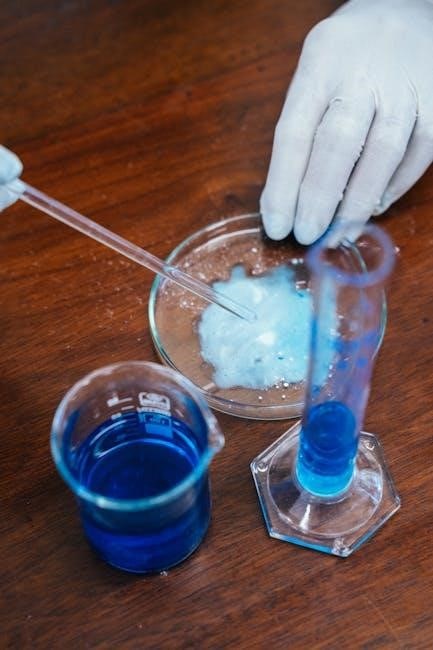
Procedure of the Iodine Clock Reaction
Prepare the solutions, mix hydrogen peroxide and potassium iodide. Add vitamin C or starch, start timer. Observe color change, record time, repeat for accurate results.
Preparation of Solutions
Begin by preparing the necessary solutions. Mix hydrogen peroxide (H2O2) with potassium iodide (KI) in a 3:2 ratio. Add distilled water to achieve the desired concentration. Stir thoroughly. Next, prepare a starch solution by dissolving starch powder in hot water until clear. This acts as an indicator. Optionally, add vitamin C to act as a catalyst. Ensure all solutions are accurately measured using a balance or volumetric flasks. Use gloves and goggles for safety. Transfer solutions to labeled containers. Store them in a cool, dry place until ready for use. Proper preparation ensures consistent and reliable results in the iodine clock reaction.
Assembly of the Reaction Mixture
Combine the hydrogen peroxide and potassium iodide solution in a 50 mL beaker. Gradually add the starch solution while stirring gently with a glass rod to avoid air bubbles. If using a catalyst like vitamin C, add it now. Dilute the mixture with distilled water to a total volume of 40 mL. Ensure thorough mixing and place the beaker in a water bath to maintain a consistent temperature. Allow the mixture to stand for 5 minutes before proceeding. This step ensures even distribution of reactants, crucial for consistent results. Always wear protective gear like gloves and goggles when handling chemicals.
Observation and Timing the Reaction
Observe the reaction mixture closely for the first sign of color change, which transitions from colorless to blue due to the formation of iodine-starch complexes. Use a timer or stopwatch to record the exact time when the mixture turns blue. Ensure the timer starts immediately after mixing the reactants. For accuracy, have multiple observers verify the color change. Note the time taken for the reaction to complete. Repeat the process for varying concentrations or temperatures to observe differences in reaction rates. Record all data systematically for later analysis. This step is critical for determining the rate constant and understanding the reaction kinetics. Always maintain safety protocols during observations.
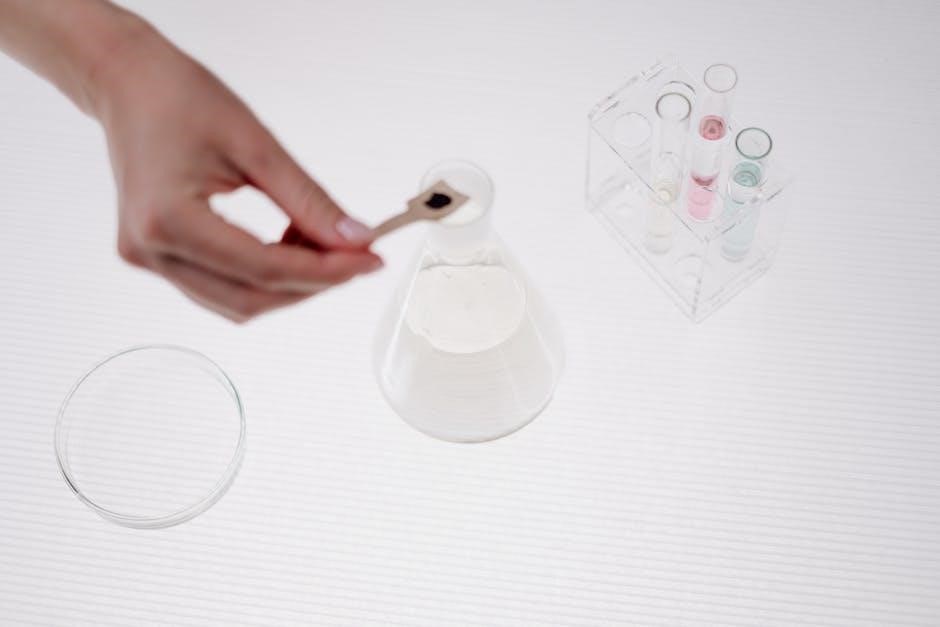
Analysis and Interpretation of Results
Analyze time vs. concentration data to determine reaction rates and orders. Graphical plots help visualize kinetics, verify rate laws, and understand reaction dependencies clearly.
Calculating the Rate Constant
The rate constant (k) is determined using concentration-time data. Plotting ln(concentration) vs. time yields a straight line, with the slope equal to -k. Using the Arrhenius equation, k = A · e-Ea/(RT), the pre-exponential factor (A) and activation energy (Ea) are calculated. Temperature and catalysts significantly impact k, as they alter reaction dynamics; By measuring the time for iodine to appear and using initial concentrations, k is derived. Repeat experiments at varying conditions to analyze consistency and accuracy. This step is critical for understanding reaction kinetics and validating theoretical models. Accurate calculations ensure reliable data for further analysis.
Determining the Order of the Reaction
The order of the iodine clock reaction is determined by analyzing how reaction rates change with varying concentrations of reactants. By systematically altering the concentration of one reactant while keeping others constant, the effect on the reaction rate is observed. The rate law is expressed as rate = k [H2O2]^m [I–]^n, where m and n are the orders with respect to hydrogen peroxide and iodide ions, respectively. The overall order is the sum of m and n. Experimental data is plotted to determine these values, ensuring accurate calculation of the reaction order and its agreement with theoretical predictions. This step is crucial for understanding the reaction mechanism and validating kinetic models.
Graphical Representation of Data
Graphical representation of data is essential for visualizing and interpreting the results of the iodine clock reaction. Common plots include concentration vs. time graphs and ln(concentration) vs. time graphs to determine the reaction order and rate constant. Scatter plots and bar graphs can illustrate the effect of varying reactant concentrations or temperatures on reaction rates. These visual tools help identify trends, confirm the reaction order, and compare experimental data with theoretical models. Graphing software or tools like Excel are typically used to create these plots. Clear labeling, consistent scales, and inclusion of error bars ensure accuracy and readability. Graphical data presentation is a key component of scientific communication, making complex kinetics more accessible and understandable. Examples of such graphs are often included in experiment reports to support conclusions.
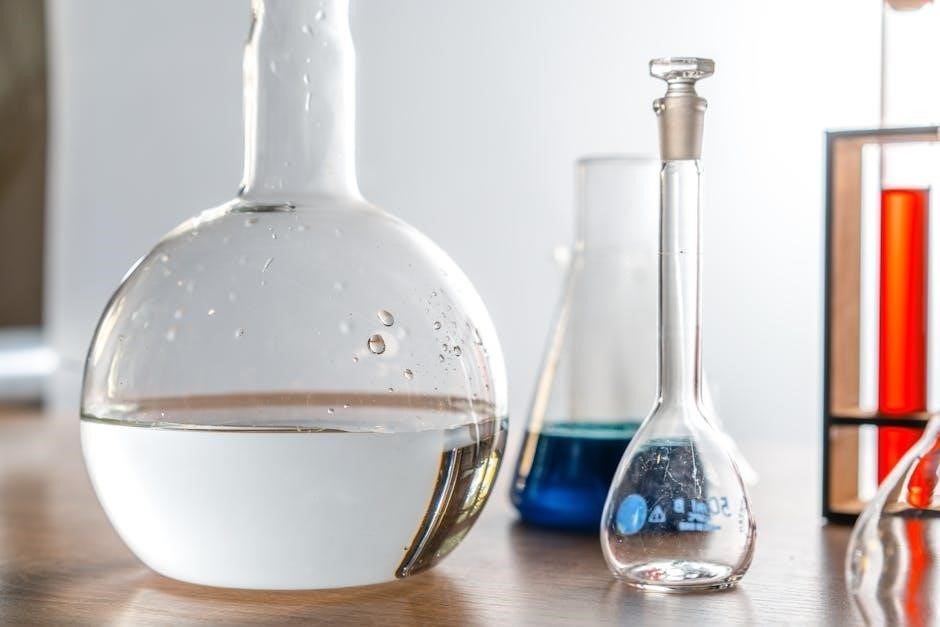
Optimization and Variations of the Experiment
Optimizing the iodine clock reaction involves adjusting concentrations, catalysts, and temperatures to achieve consistent results. Variations include using different acids, adding indicators, or exploring alternative reactions.
Effect of Concentration on Reaction Rate
The concentration of reactants significantly influences the iodine clock reaction rate. Increasing the concentration of hydrogen peroxide or iodine solutions accelerates the reaction, as molecular collisions become more frequent. Similarly, altering the concentration of acid catalysts, such as sulfuric acid, can enhance the reaction speed by stabilizing intermediates. However, excessive concentrations may lead to side reactions or instability. To observe the effect, varying the concentrations of reactants while keeping other factors constant is recommended. This variation provides insights into how concentration impacts the reaction kinetics, aligning with the principles of chemical kinetics and the rate law. Such experiments are valuable for educational purposes, demonstrating the relationship between concentration and reaction rate.
Influence of Temperature on the Reaction
Temperature plays a crucial role in the iodine clock reaction by altering the reaction rate. Increasing the temperature accelerates the reaction, as higher thermal energy increases the frequency and energy of molecular collisions. This enhances the rate at which iodine is liberated and starch-iodine complexes form. The reaction rate constant increases exponentially with temperature, following the Arrhenius equation. However, excessively high temperatures may destabilize reactants or cause side reactions. To demonstrate this effect, the experiment can be conducted at different temperatures while keeping concentrations constant. Observing the color change and timing the reaction at various temperatures provides valuable insights into how thermal energy influences reaction kinetics. This variation highlights the temperature-dependent nature of chemical reactions, making it an engaging educational tool for studying reaction dynamics.
Role of Catalysts in the Reaction
Catalysts significantly influence the iodine clock reaction by accelerating the oxidation-reduction processes. Substances like vitamin C (ascorbic acid) or hydrogen peroxide act as catalysts, lowering the activation energy required for the reaction to proceed. These catalysts alter the reaction pathway, enabling the iodine to be released more rapidly from its complex with iodide ions. The presence of a catalyst reduces the time taken for the blue-black starch-iodine complex to form, making the reaction more visible and controllable. By varying the type or concentration of the catalyst, the reaction rate can be tailored for educational demonstrations or precise timing experiments. This showcases how catalysts enhance reaction efficiency without being consumed in the process.
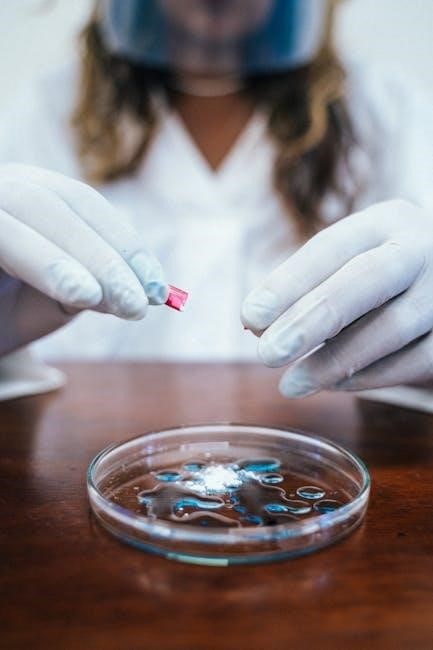
Troubleshooting and Common Issues
Troubleshooting the iodine clock reaction involves addressing issues like uneven mixing, incorrect concentrations, or impurities. Timing inconsistencies and temperature fluctuations can also affect results, requiring precise adjustments.
Identifying Sources of Error
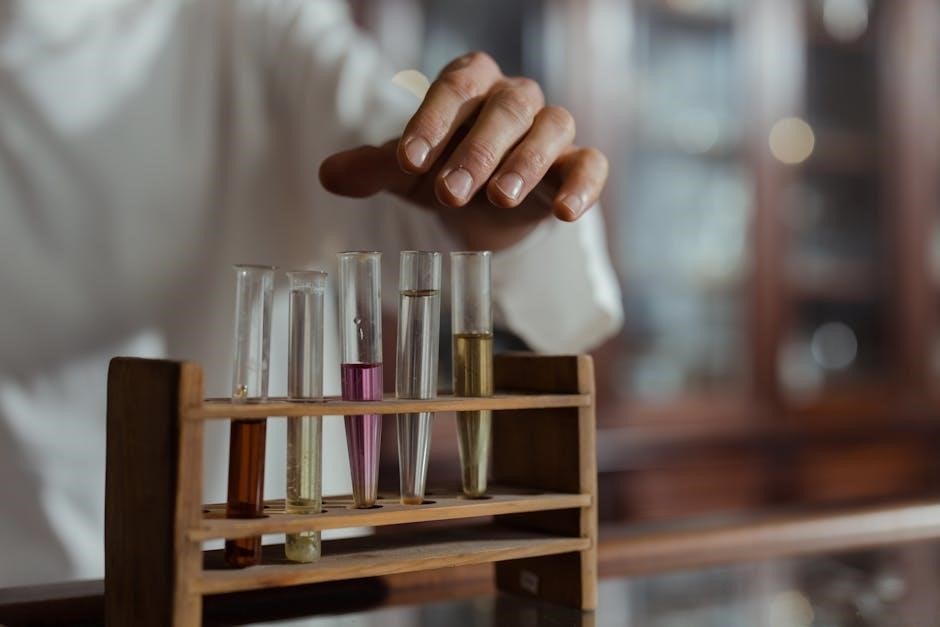
In the iodine clock reaction, common sources of error include inaccurate concentration measurements, improper mixing of reactants, and contamination from impurities. Temperature fluctuations can also significantly impact reaction rates, leading to inconsistent results. Additionally, human error in timing the reaction, such as delayed starts or stops, can introduce variability. Improper handling of chemicals or equipment, like using expired reagents or failing to clean glassware, may also affect outcomes. Finally, miscalculations during data analysis or incorrect preparation of solutions can skew results, emphasizing the need for precise methodology and careful observation to ensure reliable and reproducible experiments.
Addressing Inconsistent Results
To address inconsistent results in the iodine clock reaction, ensure precise measurement of reagent concentrations and maintain consistent temperatures throughout the experiment. Timing must be accurate, with immediate observation upon mixing reactants. Repeating trials under identical conditions can minimize variability. If inconsistencies persist, check for contamination or impurities in chemicals, as these can alter reaction dynamics. Verify the accuracy of volumetric measurements and glassware calibration. Additionally, ensure thorough mixing of reactants and adherence to the prescribed procedure. By controlling these variables and maintaining strict experimental protocols, inconsistencies can be reduced, leading to more reliable and reproducible outcomes in the iodine clock reaction experiment.
Improving Accuracy and Precision
To enhance accuracy and precision in the iodine clock reaction, use high-precision measuring tools, such as digital pipettes and volumetric flasks. Ensure all glassware is thoroughly cleaned and dried to prevent contamination. Maintain consistent temperatures by using a water bath or controlled environment. Calibrate timers and instruments before starting the experiment. Use a stopwatch with high resolution for precise timing. Conduct multiple trials under identical conditions and average the results to minimize errors. Ensure thorough mixing of reactants and avoid premature stopping of reactions. Properly prepare and standardize solutions beforehand to maintain consistent concentrations. By following these steps, the reliability and reproducibility of the iodine clock reaction experiment can be significantly improved.
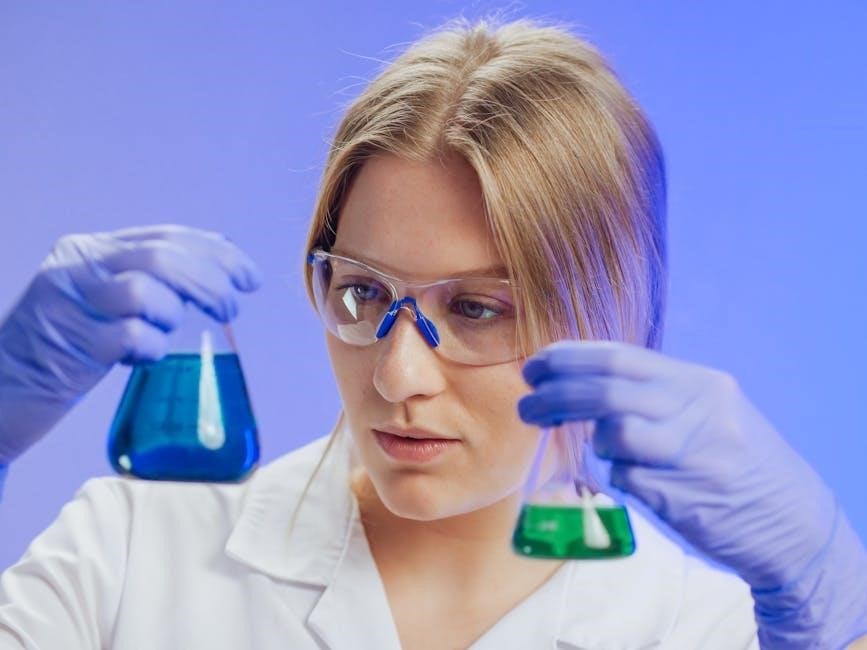
Applications and Educational Value
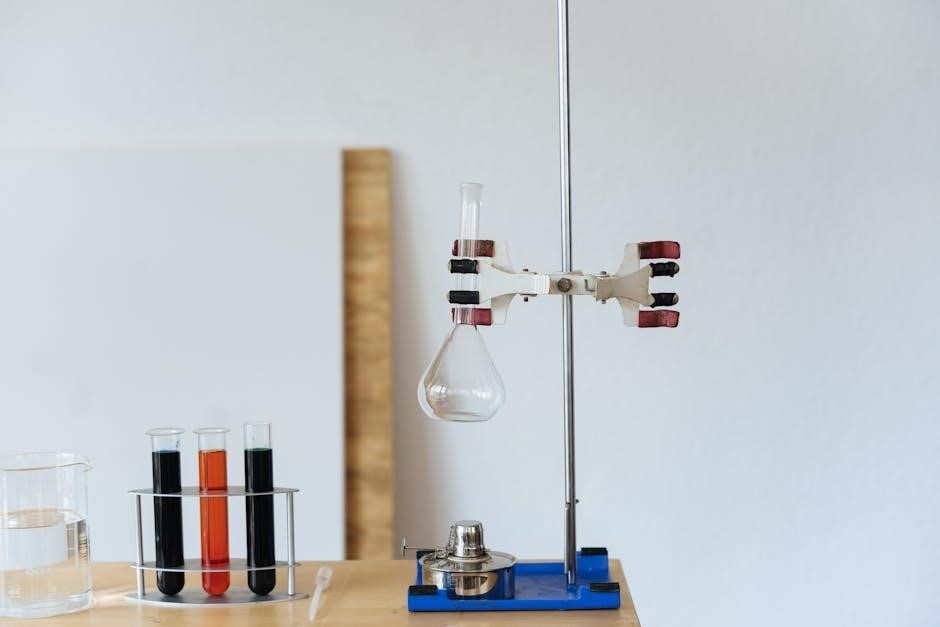
The iodine clock reaction is widely used to teach chemical kinetics, demonstrating reaction rates and catalysis. It engages students in hands-on learning, fostering curiosity in chemistry.
Use in Teaching Chemical Kinetics
The iodine clock reaction is a powerful tool for teaching chemical kinetics, enabling students to observe and measure reaction rates firsthand. It visually demonstrates how concentration, temperature, and catalysts influence reaction speeds, aligning with core kinetic principles. By timing the reaction and analyzing data, students gain practical experience with rate laws and graphical methods. This hands-on approach enhances understanding of abstract concepts like reaction orders and activation energy. The experiment also fosters critical thinking and problem-solving skills, as students interpret results and explore variables. Its simplicity and safety make it ideal for classroom settings, providing a dynamic way to engage learners in exploring chemical kinetics.
Real-World Implications of the Reaction
The iodine clock reaction holds significant real-world implications, particularly in understanding oxidation-reduction reactions and catalytic processes; It demonstrates principles applicable in industrial chemistry, such as controlling reaction rates to optimize processes. In environmental science, similar reactions are studied for water treatment and pollutant degradation. The reaction also illustrates the importance of timing and concentration in pharmaceutical synthesis, where precise control ensures product quality. Furthermore, it highlights the role of catalysts in industrial applications, such as speeding up reactions to improve efficiency. By studying this reaction, researchers can develop better methods for chemical manufacturing, waste management, and sustainable practices, showcasing its practical relevance beyond the classroom.
Inspiration for Further Research
The iodine clock reaction serves as a fascinating foundation for further scientific exploration. Its visually striking color changes and precise timing make it an excellent model for studying chemical kinetics and reaction mechanisms. Researchers can investigate how different catalysts or solvents affect the reaction’s speed and outcomes, offering insights into optimization strategies. Additionally, exploring variations, such as using alternative oxidizing agents or modifying the stoichiometry, can reveal new reaction pathways. This experiment also encourages curiosity about the role of timing and concentration in real-world processes, inspiring deeper dives into catalysis, thermodynamics, and reaction engineering. Such inquiries can spark innovative applications in fields like materials science or environmental chemistry, making the iodine clock reaction a versatile tool for advancing chemical knowledge.
The iodine clock reaction effectively demonstrates chemical kinetics, offering insights into reaction rates and mechanisms. It serves as a valuable educational tool for chemistry students.
The iodine clock reaction experiment provides clear insights into chemical kinetics, demonstrating how reaction rates are influenced by concentration, temperature, and catalysts. By observing the color change from clear to dark blue, students can measure the time required for the reaction to occur under different conditions. The experiment effectively illustrates the principles of reaction rates, highlighting the role of hydrogen peroxide as a reactant and starch as an indicator. Key findings include the exponential effect of temperature on reaction speed and the proportional relationship between reactant concentration and reaction rate. This hands-on approach simplifies complex kinetic concepts, making it an invaluable tool for educational purposes and fostering a deeper understanding of chemical reactions.
Importance of the Iodine Clock Reaction
The iodine clock reaction holds significant educational and practical value in chemistry. It serves as an engaging tool for demonstrating key concepts such as chemical kinetics, reaction rates, and the impact of variables like concentration and temperature. The reaction’s visual appeal, with its dramatic color change, makes it an effective teaching aid for students. Additionally, it highlights the role of catalysts in accelerating reactions, offering insights into industrial and real-world applications. By simplifying complex chemical principles, the iodine clock reaction fosters curiosity and understanding among learners. Its simplicity and safety also make it accessible for classroom settings, reinforcing its importance as both an educational and experimental resource.
Future Directions and Potential Studies
Future research on the iodine clock reaction could explore novel catalysts or alternative reagents to enhance reaction efficiency. Investigating the role of light or sound as external stimuli could reveal new kinetic pathways. Additionally, integrating microfluidics or automated systems could improve precision and scalability. Environmental applications, such as using the reaction to study oxidation processes in natural systems, offer promising avenues. Educators might develop interactive simulations or virtual labs to deepen student understanding. Furthermore, exploring the reaction’s potential in chemical synthesis or industrial processes could unlock practical innovations. These directions highlight the versatility of the iodine clock reaction, ensuring its continued relevance in both education and research.


